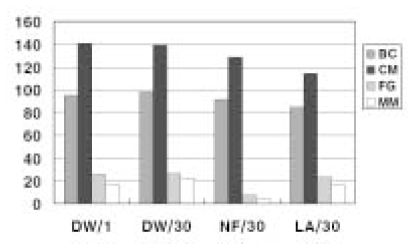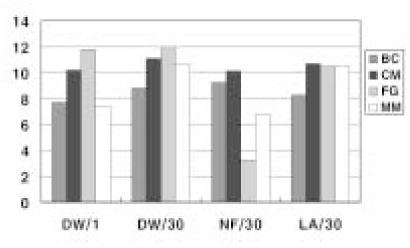J Korean Acad Conserv Dent.
2005 Mar;30(2):86-94. 10.5395/JKACD.2005.30.2.086.
The effect of environment on the physical properties of core materials
- Affiliations
-
- 1Department of Conservative Dentistry, Division of Dentistry, Graduate School, Kyunghee University, Korea. psangjin@khu.ac.kr
- 2Oral Biology Research Institute, College of Dentistry, Kyunghee University, Korea.
- KMID: 1987000
- DOI: http://doi.org/10.5395/JKACD.2005.30.2.086
Abstract
- The purpose of this study was to measure the flexural strength and hardness of four core materials in 4 different medias and to evaluate the relationship between the physical properties. For the flexural strength, the specimens were prepared from each of the following materials: Bisfil Core, Core Max, Fuji IX GP, Miracle Mix and randomly divided into four groups and stored at 37 degree C in the following medias: distilled water for 24 hours (DW/1), distilled water for 30 days (DW/30). 2% NaF for 30 days (NF/30), 0.02N lactic acid for 30 days (LA/30). After storage, the specimens were subjected to flexural strength testing and calculated to flexural modulus. For hardness testing, specimens were prepared from four materials and storaged in the uniform way. After storage, the specimens were subjected to Vicker's hardness testing. 1. The flexural strength of Core Max were the highest, and the flexural strength of Miracle Mix were the lowest. 2. The hardness of Bisfil Core were the highest. 3. The hardness of Core Max were the highest. 4. The hardness of Miracle Mix were the lowest. 5. 2% NaF and 0.02N lactic acid negatively affected the flexural strength and hardness of four core materials.
Figure
Reference
-
1. Combe EC, Shaglouf A-MS, Watts DC, Wilson NHF. Mechanical properties of Direct core materials. Dent Mater. 1999. 15:158–165.2. Cattani-Lorente MA, Dupuis V, Payan J, Moya F, Meyer JM. Effect of Water on the physical properties of resin-modified glass ionomer cements. Dent Mater. 1999. 15:71–78.
Article3. Saygili G, Mahmali SM. Comparative study of the physical properties of Core materials. Int J Periodontics Restorative Dent. 2002. 22(4):355–363.4. Yap AU, Cheang PH, Chay PL. Mechanical properties of two restorative Reinforced glass-ionomer cements. J Oral Rehabil. 2002. 29:682–688.
Article5. Bourke AW, Walls AW, McCabe JF. Light-activated glass polyalkenoate Cements; the setting reaction. J Dent. 1992. 20(2):115–120.6. Attar N, Onen A. Fluoride release and uptake characteristics of aesthetic restorative materials. J Oral Rehabil. 2002. 29(8):791–798.
Article7. Wilson AD, Kent BE. A new translucent cement for dentistry. The glass Ionomer cement. Br Dent J. 1972. 132:133–135.
Article8. Kerby RE, Knobloch L. Strength characteristics of glass-ionomer cements. Oper Dent. 1992. 17:170–174.9. McLean JW. Glass-ionomer cements. Br Dent J. 1988. 164:293–300.
Article10. MaLean JW, Gasser O. Glass-cemet cements. Quintessence Int. 1985. 16(5):333–343.11. McLean JW. Cermet cements. J Am Dent Assoc. 1990. 120(1):43–47.
Article12. Kerby RE, Bleiholder RF. Physical properties of stainless-steel and Silver-reinforced glass-ionomer cements. J Dent Res. 1991. 70(10):1358–1361.
Article13. Phantumvanit P, Songpaisan Y, Pilot T, Frencken JE. Atraumatic restorative treatment(ART); a Three-year community field trial in Thailand-Survival of one-surface Restorations in the permanent dentition. J Public Health Dent. 1991. 56:141–145.
Article14. Levartovsky S, Kuyinu E, Georgescu M, Goldstein GR. A comparison of the Diametral tensile strength, the flexural strength, and the compressive Strength of two new core materials to a silver alloy-reinforced Glassionomer material. J Prosthet Dent. 1994. 72(5):481–485.
Article15. Cohen BI, Volovich Y, Musikant BL, Deutsch AS. Comparison of the flexural strength of six reinforced restorative materials. Gen Dent. 2001. 49(5):484–488.16. Roulet JF, Walti C. Influence of oral fluid on composite resins and glass Ionomer cement. J Prosthet Dent. 1984. 52:182–186.17. Yap AU, Tan SH, Wee SS, Lee CW, Lim EL, Zeng KY. Chemical degradation of composite restoratives. J Oral Rehabil. 2001. 28(11):1015–1021.
Article18. Nicholson JW, Millar BJ, Czarnecka B, Limanowska-Shaw H. Storage of polyacid-modified resin composites in lactic acid solution. Dent Mater. 1999. 15:413–416.19. Hotta M, Hirukawa H, Aono M. The effect of glaze on restorative glass-ionomer cements: evaluation of environmental durability in lactic acid solution. J Oral Rehabil. 1995. 22(9):685–689.
Article20. Yaffe A, Zalkind M. The effect of topical application of fluorides on composite resin restorations. J Prosthet Dent. 1981. 45:59–62.
Article21. De Witte AM, De Maeyer EA, Verbeeck RM. Surface roughening of glass ionomer cements by neutral NaF solutions. Biomaterials. 2003. 24(11):1995–2000.
Article22. Choi KK, Condon JR, Ferracane JL. The effects of Adhesive Thickness on Polymerization contraction stress of Composite. J Dent Res. 2000. 79(3):812–817.
Article23. Mitra SB, Kedrowski BL. Long-term mechanical properties of glass iomers. Dent Mater. 1994. 10:78–82.24. Miyazaki M, Moore BK, Onose H. Effect of surface coatings on flexural properties of glass iononomers. Eur J Oral Sci. 1996. 104:600–604.
Article25. Kula K, McKinney JE, Kula TJ. Effects of daily topical fluoride gels on resin composite degradation and wear. Dent Mater. 1997. 13:305–311.
Article26. Bowen RJ, Cleek GW. A new series of X-ray-opaque reinforcing fillers for composite materials. J Dent Res. 1972. 51:177–182.
Article27. Hadley PC, Billington RW, Pearson GJ, Williams JA. Effect of monovalent Ions in glass ionomer cements on their ineraction with sodium fluoride solution. Biomaterials. 2000. 21(1):97–102.
Article28. Billington RW, Hadley PC, Towler MR, Pearson GJ, Williams JA. Effects of adding sodium and fluoride ions to glass ionomer on its interactions with sodium fluoride solution. Biomaterials. 2000. 21(4):377–383.
Article29. Turssi CP, Hara AT, Serra MC, Rodrigues AL Jr. Effect of storage media upon the surface micromorphology of resin-based restorative materials. J Oral Rehabil. 2002. 29(9):864–871.
Article30. Yap AU, Chew CL, Ong LF, Tech SH. Environmental damage and occlusal contact area wear of composite restoratives. J Oral Rehabil. 2002. 29(1):87–97.
Article31. Mckinney J, Wu W. Chemical softening and wear of dental composites. J Dent Res. 1985. 64(11):1326–1331.
Article32. Yap AU, Teo JC, Teoh SH. Comparative wear resistance of reinforced glass ionomer restorative materials. Oper Dent. 2001. 26(4):343–348.33. Sarkar NK. Metal-matrix interface in reinforced glass ionomers. Dent Mater. 1999. 15(6):421–425.
Article
- Full Text Links
- Actions
-
Cited
- CITED
-
- Close
- Share
- Similar articles
-
- Influence of various properties of post and core on the stress distribution in endodontically treated tooth
- INHIBITORY EFFECT OF ANTIFUNGAL AGENTS INCORPORATED IN DENTURE LINING MATERIALS AGAINST CANDIDA ALBICANS
- A study on the material properties of various composite resins for core build-up
- Evaluation of physical properties of polycarbonate temporary restoration materials
- Meta-Analysis of the Effects of Various Physical Therapy Method about Shoulder Adhesive Capsulitis: The Cases of Domestic Research




